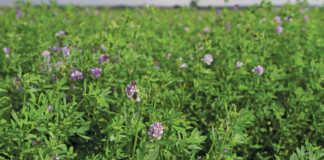
Photo: FW Archive
Originally known as the German Mutton Merino, the first sheep were imported from Germany in 1932 by the department of agriculture for a breeding programme.
The requirement was for a sheep for the winter rainfall areas that could utilise winter grazing, lamb in autumn, and rear the lambs quickly for market before the grazing deteriorated in the dry summer months.
Crosses with Merino ewes yielded lambs with good carcass qualities. By 1946, there were a number of private breeders, and a German Merino meat sheep breeders’ association was founded.
The SA Mutton Merino was developed through selection for better wool quality and conformation. The uniqueness of the South African breed was recognised in 1971 when the breed name was changed to the SA Mutton Merino.
Description
The SA Mutton Merino is a large-framed breed with a fleece of pure white wool, free of kemp and coloured fibres. Rams and ewes are polled. The breed produces good-quality wool with an average fibre diameter of 21 to 23 microns. Ewes produce an average of 3,4kg of wool, while rams produce 4,5kg.
Production norms
The breed puts on fat at a later age and can be slaughtered at a heavier live weight. Fat is distributed evenly over the carcass. Lamb carcasses of 27kg are still classed as A2 or A3. White wool is medium to strong, and over-crimped.
The breed is also used for sire lines in crossbreeding programmes, and produces heavy crossbred lambs.
The breed has contributed to the development of the Afrino, Dohne Merino and Dormer sheep breeds, among others.
Source: Snyman, MA. 2014. ‘South African sheep breeds: Suffolk sheep’. Info-pack ref. 2014/029, Grootfontein Agricultural Development Institute.










